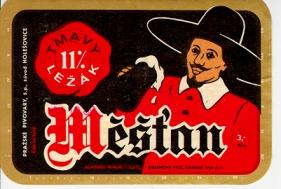A Quick and Dirty Dating Guide to Foreign Girls
Czech – These are the new “it” girls of Europe. They are all unconventionally hot. Czech porn is bookmarked in my browser. Czech girls love buying you things and they relish the sappy romantic phase of courtship. “Let’s take a walk under the moonlight” is a common refrain you’ll hear from her. Czech girls have embraced the feminist dogma of the West yet remain tied to the traditional dating mores of Eastern Europe which makes for a lot of hypocrisy. But that’s OK, because all you need to be is an oak tree for her to lean on through the storm of her emotions. The one Czech girl I was with was average in bed. Clearly, the American sense of entitlement had corrupted her after only a few months in the country.
Estonian – It has been said that the hottest girls in the world hail from Estonia’s capital Tallinn. I believe this is correct. My next trip abroad will be to Estonia. Like other European women, Estonians dress stylishly, are comfortable in their womanly skin, are naturally svelte, and love the company of men. They hate Russians so if you want to win points with her drop a casual anti-Russian remark about how you heard their women drive their men to drink and an early death. Most Estonian women are 9s and 10s with the approachability index of 6s and 7s, so when you find the rare one in DC you absolutely must go for it. They like to wear baby tees that accentuate their ample Baltic bosoms. Estonian women are so beautiful their 40 year olds are more fuckable than DC’s 25 year olds. If you are smart, spend the day with your Estonian lover being seen at your favorite pick up spots in the city. When she goes back to her country, she will leave you the parting gift of unbelievable social proof you can cash in for six months of American tail.
Finnish – If you think teasing is all part of the fun of flirting, you will not get along with a Finn. Joking banter that arouses an American girl will send a Finn rearing up with indignation at your effrontery. You will be left scratching your head at how someone could be so hypersensitive to your playful humor. I used to call my Finnish girl “finn-skinned”. She almost cried. The upside is that a Finn chick is a naif in the art of head games, so you’ll never have to deal with her flirting with other guys in a bar just to make you jealous. Finns are introverted. There is a sly Finnish joke that goes: How can you tell if you’re talking to an extroverted Finn? He looks at your shoes. But don’t mistake this aversion to sociability for weakness. Remember, these are the people who held off a much larger Soviet invading force. And the best sniper in history was this guy. A Finn girl’s introversion hides a surprising strength of character. She won’t tolerate her man walking all over her. Fiercely loyal and commitment-oriented, Finns make fantastic girlfriends. More than other women, Finns appreciate small gestures like spontaneously buying her a rocket pop from an ice cream truck. Finn girls smell fantastic and look ten years younger than their age.
Prague Pub Guide
What does this mean for anyone in search of genuine Czech pub culture? Well, for one thing, that a lot of the most historic pubs are now a complete waste of time, having forced out local drinkers with inflated prices. It means that a lot more care has to be taken in selecting places to visit, if you want to avoid the unpleasant experience of paying four or five times as much as is necessary.
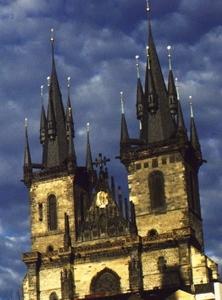 Whereas before all pubs in the same class ('skupina' in Czech) charged pretty much exactly the same prices, there are now huge differences. Unfortunately, caused by us rich foreigners happy to pay prices which, although still cheap by western European standards, are much higher than those normally charged in the country.
Whereas before all pubs in the same class ('skupina' in Czech) charged pretty much exactly the same prices, there are now huge differences. Unfortunately, caused by us rich foreigners happy to pay prices which, although still cheap by western European standards, are much higher than those normally charged in the country. It's no longer possible to hear a pub at a distance of 100 metres , the clink of glasses and the sound of voices engaged in boisterous conversation advertising the joys available inside better than any neon sign. Gone are the workers in overalls, slaking their thirst after a shift with a few well-earned beers. No more shoppers or office workers having a quick break. No; just us tourists giving the city a bad case of tourist pollution.
But the wonderful thing about acountry with such a broad and deeply-rooted beer culture, is that it consists of far more than just a handful of well-known pubs. The whole city is full of them and they almost universally offer decent beer, as well as a diverse array of environments in which to appreciate the Czech brewing skills. Away from the most obvious spots in the city centre - the Old Town Square, Wenceslas Square, Charles Bridge - old-style Czech pubs carry on. The only apparent change, apart from a proliferation of gambling machines, is a thinning out of customers through economic recession. This short guide concentrates mostly on these genuine Czech drinking houses and excludes many well-known city centre pubs which no longer have any specific attractions. I hope that it will encourage visitors to experience the real Czech drinking culture.
| Drinking in Prague | |
| Prague Pubs The traditional Czech pub in many ways resembles those which used to be found in Britain, before they were wrecked by ham-fisted 'modernisations' and 'improvements'. The serving counter is usually located by the entrance either in a sort of hallway or a small room. A barman/-woman, whose sole function is to pull beer, stands behind the taps. There is space for customers to stand and often a couple of tables, as well. This area is intended exclusively for drinking and you may well have to fetch your own beer from the bar.  Further into the building are one or more other rooms, some of which may be designated for eating only. Here you are served by a waiter or waitress. In the old days, larger establishments had a habit of employing three different waiters: one for the beer, one for the food and one who had the wallet. This practice, a nightmare for the customer trying to attract the attention of the correct waiter, thankfully seems to by dying out. In dining rooms, it's sometimes forbidden to smoke during lunchtime. This can be a very welcome relief in a country which sometimes seems to be solely populated by chain smokers. I suppose that you have to be suspicious of somewhere which has a brand of cigarettes called 'Start'. Further into the building are one or more other rooms, some of which may be designated for eating only. Here you are served by a waiter or waitress. In the old days, larger establishments had a habit of employing three different waiters: one for the beer, one for the food and one who had the wallet. This practice, a nightmare for the customer trying to attract the attention of the correct waiter, thankfully seems to by dying out. In dining rooms, it's sometimes forbidden to smoke during lunchtime. This can be a very welcome relief in a country which sometimes seems to be solely populated by chain smokers. I suppose that you have to be suspicious of somewhere which has a brand of cigarettes called 'Start'.The pubs are noticeably much emptier than in former times, when it was often difficult to find a seat except at the most unpopular times. It may make getting served a good deal easier, but it does make you worry about how many pubs are likely to close. There has already been a shakeout, with especially the smaller and grottier pubs disappearing. Klement Gottwald's old local, a wonderfully (and appropriately) scummy pub close to U Fleku, has gone. |
Food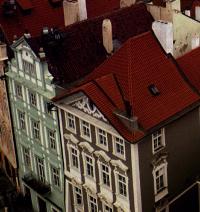 All but the smallest and lowest class drinking holes sell some sort of food, usually based around a few traditional favourites. These include goulash, roast pork and sauerkraut and pork schnitzel (veprové rizek), served with dumplings which come in a couple of different varieties. Trout pops up reasonably often and the choice for vegetarians has improved, with more now being available than the perennial fried cheese (smazeny syr) and omelette. All but the smallest and lowest class drinking holes sell some sort of food, usually based around a few traditional favourites. These include goulash, roast pork and sauerkraut and pork schnitzel (veprové rizek), served with dumplings which come in a couple of different varieties. Trout pops up reasonably often and the choice for vegetarians has improved, with more now being available than the perennial fried cheese (smazeny syr) and omelette.In a legacy from the communist days, the weight of meat in the portion is listed in the menu. The portions aren't enormous, but many of the meals or of the right size and nature to provide some necessary ballast for all that beer. Czech food used to have, for me totally undeservedly, a reputation for being boring and unhealthy. People's perceptions have now changed, though, as far as I can tell, the food itself has remained exactly the same, except for the odd bit of salad as decoration. In reality, the cuisine has always been like good home cooking, a little basic perhaps, but for the most part very tasty. Let's put it this way; given the choice of eating in a Czech, British or Dutch pub, I know which I would pick (and it wouldn't be called The Red Lion or the Prins van Oranje). | |
| Prague Beer In a welcome change for the old custom, where only a single beer was sold, most pubs now have two or three on draught. In particular, this has led to dark beers being much more widely available. When, in the 60's, pubs had cut down to serving one beer, they had usually plumped for the pale lager. 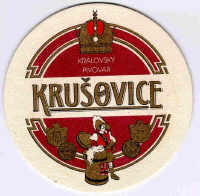 The combinations most often found are: 10% light and 10% dark; 10% light, 12% light and 10% dark; 12% light and 11/12% dark. So you often get a choice of strength, too. To many foreigners' surprise, by far the biggest seller is 10%, not the 12%. pilsener style usually associated with the Czech Republic. This is partly historical, but the pricing regime in the mid-1980's, when the price of 12% shot up 40-50% and left it costing two to three times as much as 10%, must have played its part. The combinations most often found are: 10% light and 10% dark; 10% light, 12% light and 10% dark; 12% light and 11/12% dark. So you often get a choice of strength, too. To many foreigners' surprise, by far the biggest seller is 10%, not the 12%. pilsener style usually associated with the Czech Republic. This is partly historical, but the pricing regime in the mid-1980's, when the price of 12% shot up 40-50% and left it costing two to three times as much as 10%, must have played its part.The beer taps usually have a little plaque hung on them saying what beer is being sold and what the price is. There may well also be a sign on the wall saying 'Čepujeme xxxxxx' meaning 'We sell xxxxxx on draught'. The standard measures are 0.5l and 0.3l, though if you don't specify which, they'll assume that you want the larger one. Irritatingly, some pubs, including U Fleků, have gone over to using a 0.4l measure, a fact which they don't exactly advertise, presumably in the hope that customers will assume it's a half litre. To avoid any unpleasant surprises with the prices, which can vary dramatically, try looking at the menu, which should be displayed outside, before you enter a pub. | |
| Opening Times Most pubs open before lunch and close at around 10 or 11 in the evening. Some open earlier - at 8 or 9 o' clock - but generally also close a couple of hours earlier in the evening. It used to be unknown for beer pubs (as opposed to wine restaurants or vínárna) to stay open after midnight, but there are now some which don't close until 2 or 3 AM. However, I still wouldn't count on finding anywhere selling beer after 11 at night. Note that closing time usually means when the pub will actually close, not the time of last orders. The last drinks are served about 15 minutes before closing time. | |
| Prague beer prices The price of beer in Prague, as of January 2008, should be about as follows: City centre 10%/11% : 30-35 kr for 0.5l 12%/13% : 35-40 kr for 0.5l simple meal : 100-200 kr over these prices and you're being ripped off. In the weird, parallel world of tourists, the beer prices are about double. Suburbs 10%/11% : 25 kr for 0.5l 12%/13% : 30 kr for 0.5l simple meal : 80-150 kr You're unlikely to encounter anything higher than this away from the tourist routes. Remember; if you don't use those places with ridiculous overpricing they'll eventually be forced to be more reasonable. As pubs display their prices outside, ther'e no need to even enter rip-off joints. You're not expected to leave much in the way of a tip, though the bill is usually rounded up a little. If the price of a beer is 22.80 kr, they won't give you back the odd 20 heller. Count is kept of the beers you have drunk by putting pencil marks on a slip of paper or a beermat. The price of any food you order is also marked on this slip. The waiter should write this down as you are served so, if you note the price of a beer, it's pretty easy to see if the bill is being padded. Thankfully, bent waiters are rarer than in Budapest, but it doesn't hurt to keep an eye out for this sort of dishonesty. Obviously the more touristy the pub, the greater the chance of being cheated. For more details see the Prague Interactive Beer Price Map. | |
| Prague Public Transport Prague has a excellent public transport system of trams and underground, with a single price, no matter the distance. Taxis are a bit dodgier, with the drivers having a habit of either forgetting to switch on the meter or their way around the city. Take care. |
| The Czech Language | ||||||||||||||||||||||||||||||||||||||||||||||||||||||||||
With the reduction in trade and, I suppose, a generally more competitive environment, the waiters have become much less snotty and much more co-operative. Even so, using a little Czech when ordering never does any harm. Here are a few handy words and phrases:
| ||||||||||||||||||||||||||||||||||||||||||||||||||||||||||
| Czech Beer | |
General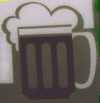 Beers are usually referred to by their strength in degrees plato: 10%, 12%, etc. This is a similar system to that of original gravity used in Britain and refers to the sugars in the wort before fermentation. It gives a rough, but not precise, idea of the strength. This varies according to the degree of attenuation, or how many of the sugars have been converted into alcohol. For example, Pilsner Urquell 12% is 4.4% alcohol, whereas Bernard 10% is 4.5%. Most beers are between 10% and 13%, with bottled table beers at 7-9% and a few special beers in the range 14% to 20%. Beers are usually referred to by their strength in degrees plato: 10%, 12%, etc. This is a similar system to that of original gravity used in Britain and refers to the sugars in the wort before fermentation. It gives a rough, but not precise, idea of the strength. This varies according to the degree of attenuation, or how many of the sugars have been converted into alcohol. For example, Pilsner Urquell 12% is 4.4% alcohol, whereas Bernard 10% is 4.5%. Most beers are between 10% and 13%, with bottled table beers at 7-9% and a few special beers in the range 14% to 20%.Draught beer is usually unpasteurised and, unless it the label says otherwise, bottled beer is similarly untreated. As a consequence, bottles often start forming a thin sediment of yeast after little more than a week. Not that this is usually a problem - Czechs don't leave beer lying around the house for very long. At one time pretty well all the beer was filtered, with the exception of that from U Fleků. A few breweries are now marketing 'kvasnicové pivo' or 'yeast beer' . This is unfiltered and has a sediment. It is mostly found in bottled form, though the Novomestsky Pivovar serves it on draught. Pre-1989, Czechoslovakia was the only country apart from the UK and Ireland where more than 50% of beer sales were on draught. This was probably connected with the fact that the price of beer was the same in pubs and supermarkets. With a price differential beginning to creep in in favour of the shops, this must be changing. Though people do still come to pubs with jugs to be filled with draught beer to drink at home. | |
| Beer Styles The Czech system of beer classification is remarkably simple: the colour and the gravity in Plato. So you get 10° dark, 12° pale, 13° amber, etc. I used to think that there were only two styles, pale and dark (I hadn't noticed the amber lagers). Brewed to a couple of strengths, which differed only in their level of alcohol. How totally wrong I was. I realised my terrible mistake when I stumbled upon some pre-war labels in German. As well as the usual 12°, 13° business they gave the beers names. Names like "Märzen", "Spezial" and "Export". Suddenly it all made sense. They don't have fewer lager styles in the Czech Republic - they have the full set. Here's a quick guide: 10° pale = Helles Schankbier 12° pale = Helles Lagerbier 13° pale = Spezial 14° pale = Export 10° amber = Vienna Schankbier 12° amber = Vienna Lagerbier 14° amber = Märzen 10° dark = Dunkles Schankbier 12° dark = Dunkles Lagerbier 13° dark = Dunkles Export 14° dark = Dunkles Märzen Recently, one brewery, Bernard, has begun to brew a wheat beer in the South German style (you can find it in the food hall of the Maj department store on Na Přikopě). Ironically, this type of beer originated in Bohemia before being adopted by the Bavarians. If you want to be pestered with my theories on the development of lager styles, look here. | |
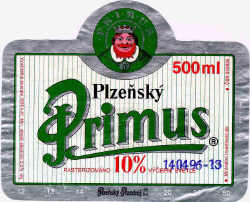 Pale Beers Pale BeersThe best-known version is 12% light, made famous by the beers of Plzeń (in German Pilsen) and Ceské Budejovice (Budweis). Though it has to be remembered that the Czech beer has little connection with what is called pils in the rest of the world. This could more appropriately called Copenhagener, as it derives from the beers brewed by Carlsberg; very pale, thin body with an aromatic, sometimes quite bitter, finish. Real pilsener is much fuller in colour - almost amber - has a big malty body with honey and fruit tones, finished off with a bitter punch of Saaz hops. A complex and well-balanced beer, where the interplay of malt and hops is of great importance. These characteristics are true, to some extent, of all Czech pale lagers, which have more body and colour than in most countries. They have an aroma all of their own, creamy with hints of yeast and bread. The 10% beers tend to be rather lighter both in body and colour, but still retain the main characteristics of the 12% beers. The best of them are tasty, satisfying and very moreish. Thankfully, their relatively low alcohol content means that 5 or 6 half litres aren't too dangerous. Outside of the UK, the Czech Republic is the only country to produce sizeable quantities of tasty and original beer of under 4% alcohol. Try the 'light' beers produced in most of the world and you will see that this is not as simple as it may appear. | |
Dark beers vary between red-brown and black in colour. The taste is mostly malty with some sweetness, though some have dry coffee and liqourice flavours more associated with stouts. | |
Serving MethodTraditional Czech beers pumps seem to use, rather than CO2, an air -pressure system, similar to that found in water pumps in Scotland. Unfortunately, standard top-pressure pumps are appearing, though, judging by the level of carbonation in the beer, they keep the pressure set pretty low.Filling each glass with patience and care, the barman gets a good thick, tight head which will leave a sucession of rings down the side of the glass as the beer is drunk. Very much the same way as beer is served in the North of England. With the oversized glasses, there's plenty of room for a big head without eating into the full measure of liquid. The philistine habit of turning up the cooler has not spread here yet and the beer comes out at cellar temperature, or 6-10 degrees C. | |
BreweriesSince the closure of Braník in 2006, Prague has only one industrial brewery, Staropramen, owned by Inbev. There are an additional six brewpubs: u Bulovky, U Fleků, Klášterní Pivovar, U Medvídků, Novoměstský pivovar and Pivovarský Dům. Beers from the Czech Republic's largest breweries - Pilsner Urquell, Gambrinus, Velké Popovice, Krušovice - are easy enough to find with, logically enough, those of Staropramen, the largest brewery in the Czech Republic predominating.The standard of beer produced has unfortunately fallen considerably in quality since 1990.With most of the large producers owned by multinationals, this situation is unlikely to improve. Amongst the pale examples, Pilsner Urquell 12% along with Budvar 12% are still decent beers. Bernard 14% and Fleku 13% are particularly fine examples of dark lagers. For more details about these breweries and the beers that they brew, take the links below. A list of all the breweries in the Czech Republic |

